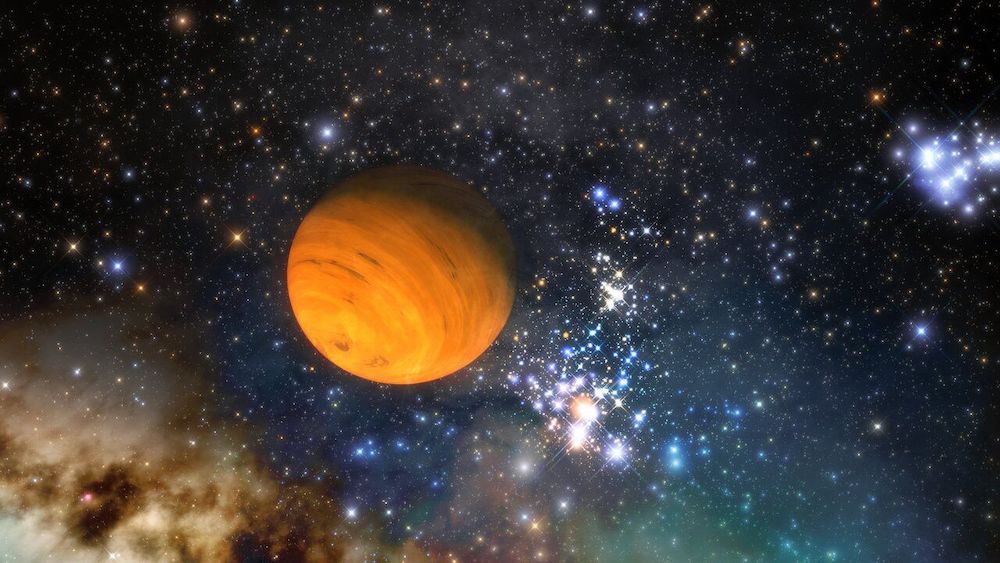Planets revolve around stars, and stars orbit the center of the galaxy. But, there are those who wander alone in interstellar and intergalactic space.
Astronomers have discovered that there are planets as well as stars that travel alone in interstellar space. Planets like this are called free-floating planets or nomad planets or the wandering planet.
Called a wanderer because this planet is not in a planetary system and does not revolve around a star. Like orphans without parents, wandering planets also don’t orbit their parent stars. There are no other stars or planets that bind the wandering planet.
The wandering planet does not have a home. But, once this planet had a home. Just like other planets, before becoming a wandering planet, this planet also formed in a planetary system with a parent star at the center. However, the violent formation process eventually caused the planet to lose its home and wander in interstellar space.
Like planets in general, wandering planets are formed from the interaction of gas and dust in the protoplanetary disk around young stars.
The particles in the disk collide and combine to form the embryo of a planet that continues to grow until it eventually forms a planet that orbits a central star.
During the process of planet formation until the system stabilizes, close passes or even collisions between the newly formed planets are common. When planets collide with each other or pass very close, the planets may be destroyed or even ejected out of the system.
Planets can indeed be ejected out of the system. This occurs due to gravitational disturbances when passing by other planets or stars. With no stars to revolve around, these planets would move with other stars in the galaxy to orbit the galactic center.
To distinguish a wandering planet from a star in this case a brown dwarf, we can look at its mass. If the object’s mass is less than 13 Jupiter masses, then the object can be classified as a wandering planet.
However, wandering planets may not always wander in interstellar space.
If in its odyssey, this nomad planet meets another star and is captured by the star’s gravity, then the planet finds a new home or system.
But if the planet is never caught by a star, it will continue to wander in interstellar space.
It is not easy to find a wandering planet. Planets do not have their own light. When the planet is ejected out of the system, it is just a cold object with no light that wanders in dark interstellar space. As a result, it is not easy for astronomers to find wandering planets.
So far, there have been 30 wandering planet candidates that have been discovered. Some of them are thought to be brown dwarfs or stars that failed to ignite their internal combustion.
Anomalies also occur in stars.
There are stars that wander alone in intergalactic space or simply these stars are not in a galaxy. These stars are known as intergalactic stars or wandering star.
Just like wandering planets, intergalactic stars or wandering stars are not originally separated from their homes. These stars are bound by gravity in a galaxy and revolve around the galactic center with other stars.
However, these stars are then ejected out of the galaxy in which they reside.
There are two ways stars can separate from galaxies. The first is galaxy collision. This event is a common thing in the universe. When a collision between galaxies occurs, the colliding galaxies will merge to form a new, larger galaxy. When the collision process between galaxies occurs, gravitational interactions cause some of the stars to be ejected into empty intergalactic space. In general, the stars ejected out during the collision process are stars from smaller galaxies.
Another way involves supermassive black holes and double stars. When a member of a double star near a supermassive black hole is pulled away by the black hole, the other star is ejected at a speed that exceeds the escape velocity of its home galaxy. As a result, the star is released from the gravitational influence that binds it within the galaxy and wanders in intergalactic space. This star also moves at high speed and is known as a hyperspeed star.
Intergalactic stars are not rare objects. Hubble Telescope observations found 600 intergalactic stars in the Virgo cluster located 60 million years from Earth. Additionally, in 2015, astronomers discovered 675 intergalactic stars at the edge of the Milky Way that point toward the Andromeda galaxy.
This article is a collaboration between detikEdu and Langitselatan and has been published on the portal detikEdu. This article was created specifically for DetikEdu from the article on Tanya LS: What is a Traveler’s Planet and Do Wandering Stars Exist?
Related
–

